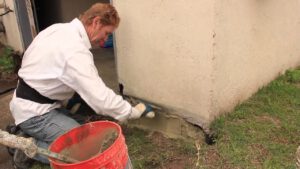Why Stucco Repair Is Important
Inspecting stucco walls often and catching water damage before it leads to mold is best. Mold grows within that waterproof layer and if not removed quickly, will eat away at the sheathing and framing of your home.
To check for underlying issues, tap on the wall–weak stucco will sound hollow while intact stucco will echo back a solid sound. Contact Stucco Repair Philadelphia for professional help.
Stucco is an extremely durable and attractive siding material that has been in use for centuries. It can last up to 50-80 years, and it is relatively low maintenance when compared to other materials. However, stucco is not immune to problems, and it is advisable for home owners to examine their outer stucco surfaces at least once a year to look for potential trouble spots like cracks or mold.
When a crack in the stucco begins to appear, it’s important for homeowners to call in their local stucco repair contractor for an inspection of the area and the cause of the damage. The contractor can assess the issue and then recommend an immediate course of action. Stucco repair typically involves the use of a mixture of liquid cement and sand that is then applied to the surface using a trowel or putty knife. This is then topped with paintable patching plaster to help even out the texture of the stucco and create a smooth surface for painting.
The cost of stucco repairs varies according to the size and scope of the work involved. Larger cracks or holes in the stucco will typically require ladders or scaffolding to access, which can significantly increase the price of the project. Similarly, if the problem is caused by moisture intrusion and results in the peeling of paint or mold growth, a more comprehensive stucco remediation may be required.
It’s also a good idea to regularly inspect the exterior of your home for signs of water damage, such as mildew or mold. These can be caused by many factors, including sprinkler systems and leaking gutters. You can prevent water damage by keeping the gutters and sprinklers in good condition, and channeling any rainwater away from the house.
In the event of mold or mildew, it’s advisable to hire a professional stucco contractor to handle the cleanup and replastering of your walls. These professionals will likely need to strip the damaged layers of your stucco down to the base layer, which is typically made from concrete. They will then fix any underlying issues that are causing the damage, and replaster the wall system with modern materials.
Repair
When stucco is damaged, it’s important to get it repaired as soon as possible. Not only does this prevent further damage, but it also helps maintain the value of your home.
Stucco repair is the process of fixing the surface layer of your home’s exterior wall to remove cracks and stains. A good way to start is by removing any existing paint and then cleaning the area thoroughly. This will help ensure that the new stucco is as close to the original as possible. Once the cleaning is done, you can begin to repair any damaged areas. This is done by using a liquid cement and sand mixture to fill in cracks and holes. You will need to apply several layers, letting each one dry before applying the next. Once the repair is completed, you can then use a stucco finish coat to even out the texture and color of the newly repaired area.
If you notice small cracks or chips, they can be patched using an acrylic caulking product. This will help to keep water out of the cracks and protect your stucco from further damage. For larger cracks, you may want to consider using a polyurethane caulking product. This will provide more durability and can handle changes in temperature. Once the caulking is applied, you can then repaint the area to match the rest of your stucco.
It’s also important to look for signs of moisture intrusion. This can include damp looking stucco after a rainstorm or dark streaks that never seem to disappear. Moisture intrusion can lead to serious problems for your stucco, including foundation issues. This is why it’s so important to look for and address any early signs of moisture intrusion.
Another sign that it’s time for a stucco repair is when you see the mesh backing starting to come off of your wall. This is a problem because it means that the structure of your house is not being supported properly. This can lead to a variety of other problems, so it’s important to address this issue as soon as possible.
Repainting
The right paint acts as a shield, guarding your stucco against weathering and prolonging the life of your home’s exterior surface. Whether the damage is from high moisture levels or UV radiation, a good paint job protects the plaster and helps prevent mold and rot.
Repainting your stucco also fills in hairline cracks that can become bigger problems if left unattended. Over time, if these cracks aren’t filled in, moisture can creep in and cause further damage to the plaster and wood framing.
Cracks that are smaller than a dime, or even as small as a pencil, can be repaired using caulking. The type of caulk used depends on the size of the crack. Acrylic caulks are great for hairline cracks, while polyurethane caulking works best for larger holes and cracks.
Before you begin, make sure the cracked or eroded areas are dry. You may need to use a hammer and chisel to remove any dirt or debris that has accumulated over time. If the damage is located close to where water has penetrated, you will need to replace the sheathing and lath.
The cost of repairing the damaged areas will depend on the location of the cracks or eroded surfaces and the overall height of the walls. Repairs on second or third story homes will require ladders and possibly scaffolding for safety, adding to the overall cost of the project.
Moisture penetration is the main cause of stucco damage. It enters through cracks, around chimneys and window and door openings, or behind torn building paper. Portland cement plaster is breathable and allows moisture vapor to pass through, but moisture that gets trapped in the walls can lead to rust and rot.
Remediation solves the underlying issues that caused the moisture intrusion. Removing and replacing the damaged sheathing, framing and insulation will not only fix the plaster but also protect the rest of your home from moisture damage in the future. If you believe your home is suffering from moisture damage, contact a trusted stucco specialist for a free estimate. They can assess the situation and provide you with a range of options that will help restore your home’s beauty and protect your investment.
Remediation
When cracks and holes in the stucco begin to form, it is essential that you do what you can to repair them as quickly as possible. This is because moisture penetration can result in a number of issues including mildew, mold, wood rot and wall rot. Ultimately, these issues can destroy the structural integrity of your home and cause thousands of dollars worth of damage to interior structures.
Stucco remediation is the most comprehensive solution to moisture intrusion and the best option if you want your home’s exterior to be protected from further damage. This involves identifying the source of the moisture and repairing it by replacing the entire stucco system. Although this is a more expensive fix upfront, it will minimize the need for future repairs and prevent your home from becoming an eyesore.
To prepare for your stucco repair, start by examining the area of the affected wall to determine if it is in good condition and if it will support a patch. If you discover that it’s in poor condition, you’ll need to replace it with new building paper and metal lath. To do this, first remove the existing stucco from the wall to expose the metal mesh underneath. Next, cut a piece of building paper to fit the repair area and secure it to the underlying sheathing or studs with galvanized nails or staples. After that, cut a piece of galvanized metal lath to the size of the patch area and affix it to the wood lath with corrosion-resistant nails or staples.
Once the building paper and lath are firmly attached to the underlying structure, you’re ready to apply your stucco patch. Whether you’re using pre-mixed stucco repair mix or conventional stucco, follow the manufacturer’s instructions for mixing and troweling on. Once the patch is applied, you can either allow it to dry naturally or use a sprayer to apply acrylic exterior caulk around the edges of the patch to protect it from moisture.
Finally, it’s important to remember that stucco changes color over time and the patch you apply may not match the existing surface. You can try to match the color by adding coloring pigment to your mix, but it will be easier if you do this before applying it to your wall.






